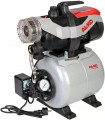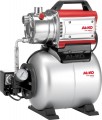Maximum performance
The maximum volume of water that the device can pump in a certain amount of time. It is one of the key specs of any pump because characterizes the volume of water with which the device can work. At the same time, it does not always make sense to pursue maximum performance — after all, it significantly affects the dimensions and weight of the unit.
Some formulas allow you to derive optimal performance values for different situations. So, if the pump is designed to supply water to water intake points, its minimum required performance should not be lower than the highest total flow rate; if desired, a margin of 20-30% can be added to this value. And for sewer models (see "Suitable for"), everything will depend on the volume of wastewater. More detailed recommendations for choosing a pump depending on performance can be found in special sources.
Suction type
The main division in this parameter is related to whether the pump can remove air from the suction line. This, in turn, determines the features of starting the unit.
— Self-priming. Self-priming pumps include all pumps that do not require the complete absence of air in the suction line at startup — it is enough that the pump itself is filled with water. Accordingly, such models are less demanding and normally tolerate air entering the line. However, this requires a reliable design that can normally withstand water hammer, which accordingly affects the cost of the unit.
— Priming. Pumps with this device can only work normally when both the unit body and the suction line are filled with water. If air enters the line, it must be removed or the pump will not be able to start normally. Such models are not as convenient as self-priming ones; at the same time, they are noticeably cheaper, and with the normal quality of the water supply system, there is practically no significant difference between the two varieties.
Pump housing material
The material from which the pump housing is made. It is a structural element in which the working mechanism (impeller or auger) is installed. Note that the motor casing can be made of a different material — this is not important in this case; and in water pumps with the engine (see “Power source”), we are talking about the casing of the pump itself, and not about the support frame in which it is fixed.
The following options are most popular nowadays:
— Plastic. Inexpensive material that perfectly resists moisture and is not subject to corrosion. However, the reliability of plastic as a whole is not very high; the exception is special high-strength grades, but they are extremely rare in pumps (when strength is needed, metals are usually used). So plastic housing is mainly equipped with relatively simple and affordable models that are not designed for serious loads.
— Cast iron. An extremely popular material nowadays: cast iron is strong, reliable, durable and at the same time has a relatively low cost. However, in terms of corrosion resistance, this material is inferior to stainless steel (see below). Nevertheless, subject to the rules for operating the pump, the service life of the cast-iron housing is not inferior to the service life of most of the main components of the unit. Also note that such cases are quite massive, which makes transportation difficult; however, in some cases, a large weight is an advantage: it helps to dampen vibrati...ons.
— Stainless steel. By the name, one of the key advantages of stainless steel is high resistance to corrosion — and, accordingly, reliability and durability. On the other hand, this material also costs a little more than the same cast iron. The weight of such housing is somewhat less — this, again, can be both an advantage and a disadvantage, depending on the situation.
— Aluminium. Premium material. The aluminium alloys used in today's pumps are light, strong, durable, and virtually impervious to moisture, but cost accordingly.
— Brass. A fairly rare option found in some models of surface pumps. Brass is strong enough, reliable and resistant to moisture, but in most cases, it does not have key advantages over the same stainless steel or aluminium but costs a little more.
— Bronze. Another material similar to the brass described above is durable and practical but rarely used.
— Ceramics. A material found exclusively in sewage pumps in the form of toilet bowls (see "Pump design"). Most often, ceramics means vitreous china or more expensive and durable vitreous china — that is, the same materials as in ordinary toilets without built-in pumps.

